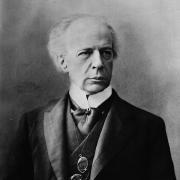 Sir Wilfrid Laurier, one of Canada's most illustrious Prime Ministers, spent much of his adult life in the Eastern Townships. Laurier, who was born in Saint-Lin in the Laurentians in 1841, studied law at McGill University where he received his degree in 1864. He practiced law in Montreal for a few years, but thereafter moved to L'Avenir in the Eastern Townships, where he served as editor of a small newspaper. Finding the Townships to his liking, Laurier took up permanent residence in Arthabaska where he built his home and continued his law practice.
Sir Wilfrid Laurier, one of Canada's most illustrious Prime Ministers, spent much of his adult life in the Eastern Townships. Laurier, who was born in Saint-Lin in the Laurentians in 1841, studied law at McGill University where he received his degree in 1864. He practiced law in Montreal for a few years, but thereafter moved to L'Avenir in the Eastern Townships, where he served as editor of a small newspaper. Finding the Townships to his liking, Laurier took up permanent residence in Arthabaska where he built his home and continued his law practice.
Laurier would later discover a passion for politics. In 1871, he was elected to the Legislative Assembly of Quebec. As MLA for Drummond-Arthabaska, he made a name for himself in the Quebec Liberal Party. In 1874, he entered federal politics, winning a seat as a Liberal in the House of Commons -- ironic for someone who had been opposed to Confederation in 1867. His charisma and his talent as an orator were obvious, and he quickly rose to prominence in Ottawa. In 1877, he was made a Cabinet Minister by Prime Minister Alexander Mackenzie. With the defeat of the Liberals in 1878, Laurier was temporarily out of the spotlight, but he continued to sit as a Member of Parliament.
Laurier was interested in local affairs, as well. Despite his busy professional life, he found time to serve as Mayor of Arthabaska.
It was the hanging of Manitoba's Métis leader, Louis Riel, that returned Laurier to the forefront of federal politics. In 1887, he became Liberal leader, and in the 1896 elections, his party defeated the long-entrenched Conservative government. Canada's new Prime Minister would hold on to power for the next 15 years - an unprecedented feat.
Described by historians as the "Father of Modern Canada," Laurier believed that the 20th century would be "Canada's Century." Key to that potential was the development of Canada's West. To this end, Laurier encouraged immigration, the construction of a second transcontinental railway, and settlement of the West, measures that would stimulate the economy. In 1905, Laurier solidified the country with the creation of two new provinces, Alberta and Saskatchewan. By the end of his term, the population of Canada had grown by two million.
Throughout his career, Laurier was known for his ability to compromise. He was a vocal defender of Canadian unity, and his famous compromises resolved a number of contentious issues, including the Manitoba schools question (minority rights) and Canadian participation in the Boer War. His ability to compromise kept him in power for 15 years, and earned him the nickname, "the Great Conciliator." In 1911, however, his solutions to two major questions (creating a Canadian Navy and Free Trade with the U.S.) finally led to his defeat at the polls.
Still a powerful voice in politics, however, Laurier remained leader of the opposition until his death in 1919. He is remembered not only as the first French Canadian Prime Minister, but as a great statesman, and as one of Canada's most eloquent and charismatic leaders. His political skills allowed him to lead his country through fifteen of its most formative years.
Sir Wilfrid Laurier always retained an affection for his adopted Eastern Townships. Even after becoming Prime Minister, and taking up residence in Ottawa, he would return every summer and during holidays to his beloved home in Arthabaska.